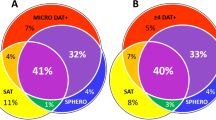Abstract
Detailed examination of the records of 57 dogs referred to our clinic with the diagnosis of immunemediated haemolytic anaemia was accomplished. Only untreated dogs or dogs who had only received supportive therapy were included in the study group comprising 30 male dogs and 27 female dogs. Age distribution followed the general age distribution of our patient population. There was no within-breed sex or age predilection. The youngest dog was 11 months of age and the oldest dog was 13 years of age. Overall mortality rate among the study population was 51% (29 dogs). Certain canine breeds were over-represented in this study and these same breeds had high mortality rates. Included were 11 cocker spaniels (19%; 82% mortality rate, 9 of 11 dogs), nine dogs with terrier in their name (16%; 78% mortality rate, 7 of 9 dogs), six German shepherds (11%; 50% mortality rate, 3 of 6 dogs), five doberman pinschers (9%; 60% mortality rate, 3 of 5 dogs), and five miniature schnauzers (9%; 60% mortality rate, 3 of 5 dogs). Immune-mediated haemolytic anaemia was considered secondary to hepatic disease in 16 dogs (28%), septicaemia in 10 dogs (18%) and neoplasia in six dogs (11%), i.e. signs and data supporting these processes were reported to have preceded anaemia. A total of 29 dogs (51%) also had thrombocytopenia (platelet counts less than 60000 cells/µl), eight (14%) dogs had major venous thrombosis, eight (14%) dogs had associated disseminated intravascular coagulation, and 24 (42%) of the dogs had evidence of renal disease — proteinuria and cylinduria. About 35% (20 dogs) of the patients were treated from June to August, and 63% (36 dogs) of the patients were direct antiglobulin positive (immunoglobulin G with or without complement). A variety of red cell morphological changes were observed including stomatocytes, bowl forms, knizocytes, schistocytes and spherocytes. Spherocytes were observed in 11 dogs (19%). Absolute reticulocytosis was observed in 26 dogs (46%). A variety of treatment combinations including glucocorticoids, azathioprine, cyclophosphamide, anabolic steroids, heparin, intravenous human gamma globulin, and blood component therapy were used without identifiable success associated with any given protocol.
Similar content being viewed by others
References
Ahn YS, Harrington WJ (1985) Danazol therapy for autoimmune hemolytic anemia. Ann Intern Med 102:298–301
Habibi B, Homberg J, Schaison C et al. (1974) Autoimmune hemolytic anemia in children: a review of 80 cases. Am J Med 56:61–69
Hilgartner NW, Bussel J (1987) Use of intravenous gamma globulin for the treatment of autoimmune neutropenia of childhood and autoimmune hemolytic anemia. Am J Med 83:25–29
Jackson ML, Kruth SA (1985) Immune-mediated hemolytic anemia and thrombocytopenia in the dog. a retrospective study of 55 cases diagnosed from 1969 through 1983 at the Western College of Veterinary Medicine. Can Vet J 26:245–250
Jain NC (1986) Examination of blood and bone marrow. In: Jain NC, Schalm's veterinary hematology, 4th edn, Lea and Febiger, Philadelphia, pp 1–19
Jones DRE (1986) Use of an enzyme indirect antiglobulin test for the diagnosis of autoimmune hemolytic anemia in the dog. Res Vet Sci 41:187–190
Klaq A, Giger U, Shofer S (1992) IHA in the dog: retrospective study of 42 cases. Proceedings of the 10th American College of Internal Medicine Forum. p. 807
Kurtzberg J, Friedman HS (1987) Efficacy of intravenous gamma globulin in immune-mediated pediatric blood dyscrasias. Am J Med 83:4–9
Liesveld JL, Rowe JM, Lichtman MA (1987) Variability of erythroid response in autoimmune hemolytic anemia. Analysis of 109 cases. Blood 69:820–826
Mitchell CA, Van der Weyden BM, Firkin BG (1987) High dose intravenous gamma globulin in Coombs' positive hemolytic anemia. Aust NZ J Med 17:270–274
Mylvaganum R, Ahn YS, Harrington WJ et al. (1987) Immune modulation by danazol in autoimmune thrombocytopenia. Immunol Immunother 42:281–287
Park D, Yang C, Kim K (1987) Autoimmune hemolytic anemia in children. Yonsei Med J 28:313–321
Schreiber A, Frank M (1988) Acquired hemolytic anemia. In: Samter M (ed) Immunological diseases, 4th edn. Little Brown, Boston, pp 1120–1174
Schreiber A, Chien P, Tomaski A et al. (1987) Effect of danazol in immune thrombocytopenic purpura. N Engl J Med 316:503
Slappendel RJ (1986) Interpretation of tests for immune-mediated blood diseases. In: Kirk RW (ed) Current veterinary therapy. IX Small animal practice, WB Saunders, Philadelphia, pp 498–505
Stewart AF, Feldman BF (1993a) Immune-mediated hemolytic anemia. Part I. An overview. Comp Cent Educ Practicing Vet 15:372–381
Stewart AF, Feldman BF (1993b) Immune-mediated hemolytic anemia. Part 11. Clinical entity, diagnosis, and treatment theory. Comp Cont Educ Practicing Vet 15:1479–1491
Warren RW, Collins ML (1988) Immune hemolytic anemia in children. Crit Rev Hematol Oncol 9:65–73
Author information
Authors and Affiliations
Rights and permissions
About this article
Cite this article
Feldman, B.F. Demographics of canine immune-mediated haemolytic anaemia in the Southeastern United States. Comp Haematol Int 6, 42–45 (1996). https://doi.org/10.1007/BF00368101
Issue Date:
DOI: https://doi.org/10.1007/BF00368101




